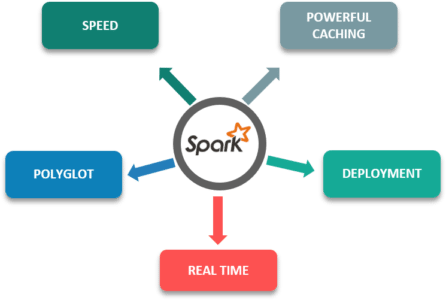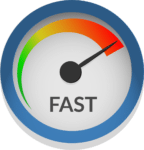Azure Data Engineer Associate Certification C ...
- 2k Enrolled Learners
- Weekend
- Live Class
Apache Spark is one the most widely used framework when it comes to handling and working with Big Data AND Python is one of the most widely used programming languages for Data Analysis, Machine Learning and much more. So, why not use them together? This is where Spark with Python also known as PySpark comes into the picture.
With an average salary of $110,000 pa for an Apache Spark Developer, there’s no doubt that Spark is used in the industry a lot. Because of its rich library set, Python is used by the majority of Data Scientists and Analytics experts today. Integrating Python with Spark was a major gift to the community. Spark was developed in Scala language, which is very much similar to Java. It compiles the program code into bytecode for the JVM for spark big data processing. To support Spark with python, the Apache Spark community released PySpark. Ever since, PySpark Certification has been known to be one of the most sought-after skills throughout the industry due of the wide range of benefits that came after combining the best of both these worlds. In this Spark with Python blog, I’ll discuss the following topics.
Apache Spark is an open-source cluster-computing framework for real-time processing developed by the Apache Software Foundation. Spark provides an interface for programming entire clusters with implicit data parallelism and fault-tolerance.
Below are some of the features of Apache Spark which gives it an edge over other frameworks:

Although Spark was designed in scala, which makes it almost 10 times faster than Python, but Scala is faster only when the number of cores being used is less. As most of the analysis and process nowadays require a large number of cores, the performance advantage of Scala is not that much.

For programmers Python is comparatively easier to learn because of its syntax and standard libraries. Moreover, it’s a dynamically typed language, which means RDDs can hold objects of multiple types.

Although Scala has SparkMLlib it doesn’t have enough libraries and tools for Machine Learning and NLP purposes. Moreover, Scala lacks Data Visualization.
I hope you guys know how to download spark and install it. So, once you’ve unzipped the spark file, installed it and added it’s path to .bashrc file, you need to type in source .bashrc
export SPARK_HOME = /usr/lib/hadoop/spark-2.1.0-bin-hadoop2.7
export PATH = $PATH:/usr/lib/hadoop/spark-2.1.0-bin-hadoop2.7/bin
To open pyspark shell you need to type in the command ./bin/pyspark
Apache Spark because of it’s amazing features like in-memory processing, polyglot and fast processing are being used by many companies all around the globe for various purposes in various industries:

Yahoo uses Apache Spark for its Machine Learning capabilities to personalize its news, web pages and also for target advertising. They use Spark with python to find out what kind of news – users are interested to read and categorizing the news stories to find out what kind of users would be interested in reading each category of news.
TripAdvisor uses apache spark to provide advice to millions of travelers by comparing hundreds of websites to find the best hotel prices for its customers. The time taken to read and process the reviews of the hotels in a readable format is done with the help of Apache Spark.
One of the world’s largest e-commerce platform Alibaba runs some of the largest Apache Spark jobs in the world in order to analyze hundreds of petabytes of data on its e-commerce platform.
Talking about Spark with Python, working with RDDs is made possible by the library Py4j. PySpark Shell links the Python API to spark core and initializes the Spark Context. Spark Context is the heart of any spark application.


Now Let’s have a look at a Use Case of KDD’99 Cup (International Knowledge Discovery and Data Mining Tools Competition). Here we will take a fraction of the dataset because the original dataset is too big
import urllib
f = urllib.urlretrieve ("http://kdd.ics.uci.edu/databases/kddcup99/kddcup.data_10_percent.gz", "kddcup.data_10_percent.gz")
data_file = "./kddcup.data_10_percent.gz" raw_data = sc.textFile(data_file)
Suppose We want to count how many normal. interactions we have in our dataset. We can filter our raw_data RDD as follows.
normal_raw_data = raw_data.filter(lambda x: 'normal.' in x)
Now we can count how many elements we have in the new RDD.
from time import time
t0 = time()
normal_count = normal_raw_data.count()
tt = time() - t0
print "There are {} 'normal' interactions".format(normal_count)
print "Count completed in {} seconds".format(round(tt,3))
Output:
There are 97278 'normal' interactions Count completed in 5.951 seconds
In this case we want to read our data file as a CSV formatted one. We can do this by applying a lambda function to each element in the RDD as follows. Here we will use the map() and take() transformation.
from pprint import pprint
csv_data = raw_data.map(lambda x: x.split(","))
t0 = time()
head_rows = csv_data.take(5)
tt = time() - t0
print "Parse completed in {} seconds".format(round(tt,3))
pprint(head_rows[0])
Output:
Parse completed in 1.715 seconds [u'0', u'tcp', u'http', u'SF', u'181', u'5450', u'0', u'0', . . u'normal.']
Now we want to have each element in the RDD as a key-value pair where the key is the tag (e.g. normal) and the value is the whole list of elements that represents the row in the CSV formatted file. We could proceed as follows. Here we use the line.split() and map().
def parse_interaction(line):
elems = line.split(",")
tag = elems[41]
return (tag, elems)
key_csv_data = raw_data.map(parse_interaction)
head_rows = key_csv_data.take(5)
pprint(head_rows[0])
Output: (u'normal.', [u'0', u'tcp', u'http', u'SF', u'181', u'5450', u'0', u'0', u'0.00', u'1.00', . . . . u'normal.'])
Here we are going to use the collect() action. It will get all the elements of RDD into memory. For this reason, it has to be used with care when working with large RDDs.
t0 = time()
all_raw_data = raw_data.collect()
tt = time() - t0
print "Data collected in {} seconds".format(round(tt,3))
Output:
That took longer as any other action we used before, of course. Every Spark worker node that has a fragment of the RDD has to be coordinated in order to retrieve its part and then reduce everything together.
As a last example combining all the previous, we want to collect all the normal interactions as key-value pairs.
# get data from file
data_file = "./kddcup.data_10_percent.gz"
raw_data = sc.textFile(data_file)
# parse into key-value pairs
key_csv_data = raw_data.map(parse_interaction)
# filter normal key interactions
normal_key_interactions = key_csv_data.filter(lambda x: x[0] == "normal.")
# collect all
t0 = time()
all_normal = normal_key_interactions.collect()
tt = time() - t0
normal_count = len(all_normal)
print "Data collected in {} seconds".format(round(tt,3))
print "There are {} 'normal' interactions".format(normal_count)
Output:
Data collected in 12.485 seconds There are 97278 normal interactions
So this is it, guys!
I hope you enjoyed this Spark with Python blog. If you are reading this, Congratulations! You are no longer a newbie to PySpark. Try out this simple example on your systems now.
Now that you have understood basics of PySpark, check out the Python Spark Certification Training using PySpark by Edureka, a trusted online learning company with a network of more than 250,000 satisfied learners spread across the globe. Edureka’s Python Spark Certification Training using PySpark is designed to provide you the knowledge and skills that are required to become a successful Spark Developer using Python and prepare you for the Cloudera Hadoop and Spark Developer Certification Exam (CCA175).
Got a question for us? Please mention it in the comments section and we will get back to you.
| Course Name | Date | |
|---|---|---|
| PySpark Certification Training Course | Class Starts on 4th March,2023 4th March SAT&SUN (Weekend Batch) | View Details |
 REGISTER FOR FREE WEBINAR
REGISTER FOR FREE WEBINAR  Thank you for registering Join Edureka Meetup community for 100+ Free Webinars each month JOIN MEETUP GROUP
Thank you for registering Join Edureka Meetup community for 100+ Free Webinars each month JOIN MEETUP GROUP
edureka.co
